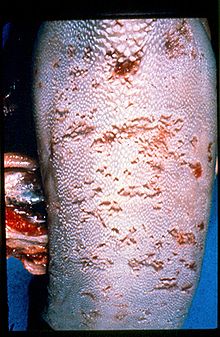
Back إسهال فيروسي عند الأبقار Arabic Bovinní virová diarrhea Czech BVD/MD German Diarrea viral bovina Spanish Diarrhée virale bovine French מחלת הריריות בבקר HE Diare ganas sapi ID Diarrea virale bovina Italian 牛ウイルス性下痢 Japanese Boviene virale diarree Dutch
| Bovine viral diarrhea | |
|---|---|

| |
| Immunofluorescence image of BVDV (CP7 type). Nuclei are stained blue with DAPI. The replication complexes of the viruses are marked red by NS3 protein binding antibodies | |
| Scientific classification | |
| (unranked): | Virus |
| Realm: | Riboviria |
| Kingdom: | Orthornavirae |
| Phylum: | Kitrinoviricota |
| Class: | Flasuviricetes |
| Order: | Amarillovirales |
| Family: | Flaviviridae |
| Genus: | Pestivirus |
| Groups included | |
| |
| Cladistically included but traditionally excluded taxa | |

Bovine viral diarrhea (BVD), bovine viral diarrhoea (UK English) or mucosal disease, previously referred to as bovine virus diarrhea (BVD), is an economically significant disease of cattle that is found in the majority of countries throughout the world.[1] Worldwide reviews of the economically assessed production losses and intervention programs (e.g. eradication programs, vaccination strategies and biosecurity measures) incurred by BVD infection have been published.[2][3] The causative agent, bovine viral diarrhea virus (BVDV), is a member of the genus Pestivirus of the family Flaviviridae.[1]
BVD infection results in a wide variety of clinical signs, due to its immunosuppressive effects,[4] as well as having a direct effect on respiratory disease and fertility.[5] In addition, BVD infection of a susceptible dam during a certain period of gestation can result in the production of a persistently infected (PI) fetus.[6]
PI animals recognise intra-cellular BVD viral particles as ‘self’ and shed virus in large quantities throughout life; they represent the cornerstone of the success of BVD as a disease.
Currently, it was shown in a worldwide review study that the PI prevalence at animal level ranged from low (≤0.8% Europe, North America, Australia), medium (>0.8% to 1.6% East Asia) to high (>1.6% West Asia). Countries that had failed to implement any BVDV control and/or eradication programmes (including vaccination) had the highest PI prevalence.[7]
- ^ a b Fray, M.D; Paton, D.J; Alenius, S.; et al. (2000). "The effects of bovine viral diarrhoea virus on cattle reproduction in relation to disease control". Animal Reproduction Science. 60–61: 615–27. doi:10.1016/s0378-4320(00)00082-8. PMID 10844229.
- ^ Richter, V; Lebl, K; Baumgartner, W; Obritzhauser, W; Käsbohrer, A; Pinior, B (2017). "A systematic worldwide review of the direct monetary losses due to bovine viral diarrhea virus infection". The Veterinary Journal. 220: 80–87. doi:10.1016/j.tvjl.2017.01.005. PMID 28190502.
- ^ Pinior, B; Firth, C; Richter, V; Lebl, K; Trauffler, M; Dzieciol, M; Hutter, S; Burgstaller, J; Obritzhauser, W; Winter, P; Käsbohrer, A (2017). "A systematic review of financial and economic assessments of bovine viral diarrhea virus (BVDV) prevention and mitigation activities worldwide". Preventive Veterinary Medicine. 137 (Pt A): 77–92. doi:10.1016/j.prevetmed.2016.12.014. PMID 28040270.
- ^ Schaut, Robert G.; McGill, Jodi L.; Neill, John D.; Ridpath, Julia F.; Sacco, Randy E. (2015-10-02). "Bovine viral diarrhea virus type 2 in vivo infection modulates TLR4 responsiveness in differentiated myeloid cells which is associated with decreased MyD88 expression". Virus Research. 208: 44–55. doi:10.1016/j.virusres.2015.05.017. ISSN 1872-7492. PMID 26043978.
- ^ Lanyon, Sasha R.; Hill, Fraser I.; Reichel, Michael P.; Brownlie, Joe; et al. (2014). "Bovine Viral Diarrhoea: Pathogenesis and diagnosis" (PDF). Veterinary Journal. 199 (2): 201–9. doi:10.1016/j.tvjl.2013.07.024. PMID 24053990.
- ^ Grooms, Daniel L. (2004). "Reproductive consequences of infection with bovine viral diarrhea virus". Veterinary Clinics of North America: Food Animal Practice. 20 (1): 5–19. doi:10.1016/j.cvfa.2003.11.006. PMID 15062471.
- ^ Scharnböck, B; Roch, Franz-Ferdinand; Richter, V; Funke, C; Firth, C; Obritzhauser, W; Baumgartner, W; Käsbohrer, A; Pinior, B (2018). "A meta-analysis of bovine viral diarrhoea virus (BVDV) prevalences in the global cattle population". Scientific Reports. 8 (1): 14420. Bibcode:2018NatSR...814420S. doi:10.1038/s41598-018-32831-2. PMC 6158279. PMID 30258185.